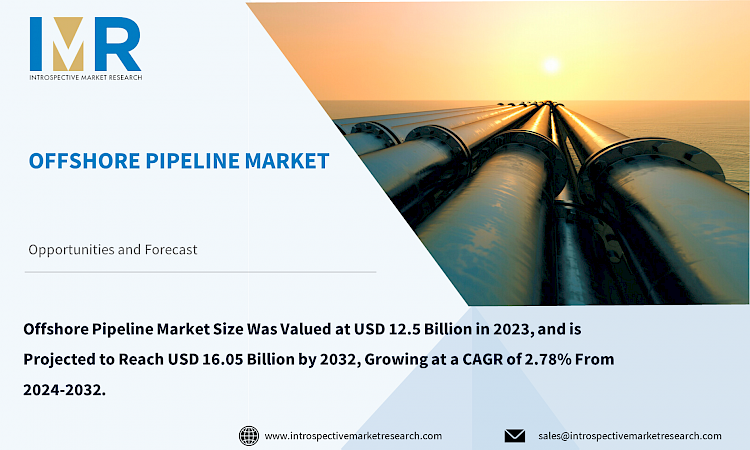Offshore Pipeline Market
According to a new report published by Introspective Market Research, titled, ?Offshore Pipeline Market by Product, Basis of Line, and Diameter: Global Opportunity Analysis and Industry Forecast, 2024?2032,?
the global Offshore Pipeline Market Size Was Valued at USD 12.5 Billion in 2023, and is Projected to Reach USD 16.05 Billion by 2032, Growing at a CAGR of 2.78% From 2024-2032.
Offshore pipelines are crucial for transporting oil and gas from offshore production to downstream facilities, a demand set to rise with growing energy needs, especially in developing nations. The market is expanding due to new opportunities in oil, natural gas, offshore wind farms, and CCS projects. Deepwater explorations require complex pipeline systems, driving advancements in high-pressure pipelines. Offshore wind farms necessitate extensive subsea electrical connections, boosting the offshore pipeline market. Additionally, CCS projects use offshore pipelines to transport CO2 for storage, addressing climate change. Despite risks like regulatory hurdles, environmental concerns, and geopolitical tensions, technological advancements, and increasing energy consumption ensure the offshore pipeline market's growth and evolution.
According to the global Offshore Pipeline market analysis, the market is divided by Product, Basis of Line, and Diameter and geographical division. By Product (Oil, Gas, And Refined Products), By Basis of Line (Export Line and Transport Line), and By Diameter (Below 24? And Greater than 24?) By geography, it includes North America, Europe, Asia-Pacific, and LAMEA markets. Further, the report also covers the strategies adopted by key market players to sustain competitive environment and increase their market share.
Digital technologies, including IoT sensors, data analytics, and digital twins, enhance pipeline maintenance, design, and operation. Automation, utilizing drones and ROVs, improves inspection efficiency and safety, while smart technologies enable remote monitoring, crucial during the COVID-19 era. Shifting from fossil fuels to renewable energy, driven by climate change concerns, governments are promoting clean energy through policies, tax incentives, and subsidies. Technological advancements in offshore wind turbines and foundation construction have reduced costs and improved reliability. This transition presents significant business opportunities, increasing demand for pipelines in renewable energy projects, particularly offshore wind farms.
Global Offshore Pipeline Market, Segmentation
The Offshore Pipeline market is segmented based on Product, Basis of Line, and Diameter, and region.
Product:
The rising global energy demand, especially in developing countries, highlights the importance of efficient transportation from offshore fields to onshore facilities. Advances in pipeline construction technology, both in civil and mechanical engineering, have enhanced safety, efficiency, and environmental sustainability, spurring investment in new offshore pipelines. Ongoing conflicts in oil and gas-producing regions underscore the need for additional pipelines to diversify supply and reduce risks. Furthermore, growing environmental awareness is driving the adoption of eco-friendly energy sources and safer offshore pipeline designs, influencing investment in these projects.
Basis of Line:
Export pipelines transfer hydrocarbons from offshore facilities to onshore refineries, designed to withstand harsh marine conditions and resist corrosion. Transport pipelines convey processed products from onshore facilities to offshore platforms, ensuring a stable supply chain. Key factors influencing market growth include rising offshore exploration and production (E&P) operations, increasing energy demands, advancements in pipeline technology and inspection, and a focus on safety and environmental standards. Expanding networks to new deep-water fields and ongoing R&D for better materials and construction methods are essential. This sector offers significant opportunities for pipeline manufacturers, engineering firms, and hydrocarbon processing industries amid growing global offshore E&P activities.
Region:
Europe leads the offshore pipeline market due to strategic coastal locations and investment appeal. Key drivers include significant investments in green energy, particularly offshore wind farms, necessitating extensive pipeline networks to transport electricity to onshore grids. High environmental standards and legal reforms demand advanced technology and expertise in pipeline infrastructure, fostering innovation. Additionally, the EU's focus on energy security and diversification has spurred investment in pipelines for natural gas and oil transport from offshore fields to onshore facilities. Consequently, Europe's geographical advantages, commitment to environmental sustainability, and energy security priorities establish its dominance in the offshore pipeline market in 2024.
Some of The Leading/Active Market Players Are-
- TechnipFMC Plc (UK)
- Petrofac Limited (UK)
- McDermott (US)
- Fugro (The Netherlands)
- Saipem (Italy)
- Enbridge Inc. (Canada)
- Cortez Subsea (UK), and Other Active Players
Key Industry Developments
- In February 2023, DNV launched the second phase of H2Pipe, a joint industry project to develop a new code for offshore hydrogen pipelines. DNV?s Hydrogen Forecast to 2050 predicts over 50% of hydrogen pipelines will be repurposed from natural gas networks, costing less than 35% of new builds.
- In January 2024, TotalEnergies signed an agreement with European Energy to develop offshore wind projects in Denmark, Finland, and Sweden. This includes acquiring stakes in Denmark's Jammerland Bugt (240 MW) and Lillebaelt South (165 MW) projects, both expected to start by 2030. The partnership aims for large-scale projects and tender bids in all three countries.
Key Findings of the Study
- The global offshore pipeline market, valued at USD 12.5 billion in 2023, is forecasted to reach USD 16.05 billion by 2032, growing at a CAGR of 2.78% from 2024 to 2032. This growth is driven by increasing energy demands worldwide, particularly in developing nations, and expanding applications in oil, gas, offshore wind, and carbon capture projects.
- Advances in pipeline construction technology, such as high-pressure systems for deepwater explorations and smart monitoring tools like IoT sensors and digital twins, are enhancing safety, efficiency, and environmental sustainability. Automation through drones and ROVs is improving inspection processes, crucially supporting maintenance operations even in remote and challenging offshore environments.






